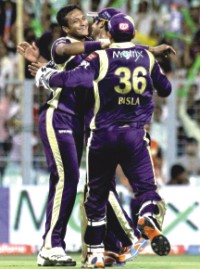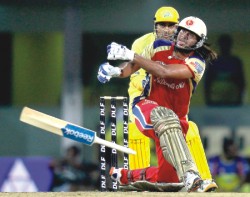| Home - Back Issues - The Team - Contact Us |
 |
| Volume 10 |Issue 22 | June 10, 2011 | |
|
|
Sport
Mohammad Isam
It was all down to Chris Gayle to liven up the occasion one last time. But he edged one to Mahendra Singh Dhoni in the first over of the Bangalore Royal Challengers' improbable chase in the final, giving the Chennai Super Kings a second successive title. The fourth edition of the Indian Premier League (IPL) owes much to this Jamaican big-hitter for keeping the ball rolling and giving the sense of adventurism that it has lacked the whole time. The IPL, which began a week after the blockbuster World Cup ended, only came to life when Gayle signed up for the Bangalore Royal Challengers after being passed up by all ten franchises in the January auction. It was perceived that since Pakistan will be touring West Indies during the IPL, Gayle would only be available for a handful of matches. However, the West Indian Cricket Board (WICB) decided to drop Gayle due to past power struggles and what was West Indies's loss was the IPL's gain and ultimately, its best player. Called up as a replacement for Dirk Nannes a fortnight into the tournament, Gayle arrived to play his first game at Eden Gardens, his old stomping ground with the Knight Riders. It took him just 55 balls, during which he pounded 102, to prove that jet-lag is for uncool people who don't wear 333 [his highest Test score] on their backs. S There was also a 46-ball century against Punjab and a withering 47-ball 89 that dumped the Mumbai Indians out of the competition. Even in the final, Chennai, with 205 on the board, did not breathe easy till he started that languid walk back to the pavilion. He finished with 608 runs at 67.55 and only Virender Sehwag came remotely close to matching his strike-rate (183.13). Cricket's coolest dude also clubbed 44 sixes. MS Dhoni, in second place, had 23. Apart from Gayle's exploits, it was always going to be Shakib Al Hasan who would pique the interest among Bangladeshis. The skipper didn't disappoint: a haul of eleven wickets from seven games and though he batted only twice in the competition, he showed what the Kolkata Knight Riders were missing in their batting line-up. Shakib's matches were keenly followed across the country, though it was disappointing that he was the only one among the Tigers to be drawing the IPL's attention. Shakib maintained his form till the end, taking wickets for the Kolkata Knight Riders whenever required. His fielding, of course, remained world-class. When the tournament actually began back in April, it had garnered little interest, even among the players. Just a week after the groundswell of India's World Cup victory, a player like Virat Kohli, a star in the campaign, was lining up against players he had wept with at the Wankhede. One day, he was playing against his captain, MS Dhoni, except he wasn't his captain anymore. The next day, Yuvraj Singh had to be stopped from scorching turf, Harbhajan Singh had be stepped out to, and a way had to be found to make Gautam Gambhir step over the line. Kohli had played the IPL before, had understood what it was all about, yet getting right into it took slightly longer this year.
Kohli describes his first week in the IPL as “confusing". For the World Cup winners, it was tough, to motivate themselves, to actually be at their best. “We weren't up to that mental level, to be honest,” he told ESPNCricinfo in an interview last week. Crowds struggled too, not only with feelings of satiation, but also with identity. Most of the teams were unrecognisable from the squads of the first three seasons, and a combination of the oppressive heat, the ridiculously expensive tickets and an itinerary that never seemed to end (74 games, instead of the previous 60) meant that few stadiums were full on match days. According to a study done by Cricinfo, TV ratings were down by as much as 25 percent in the major cities, and the nadir was reached when the Mumbai Indians played Kolkata Knight Riders at the Wankhede Stadium in what was effectively a quarter-final. Not even the presence of Sachin Tendulkar could fill the seats. Two of the stands were nearly empty. There was some fear that the Lalit Modi-less IPL would lose most of its glamour. The tournament commissioner of the first three editions has been packed off on a hiatus after irregularities regarding team induction and ownership surfaced. Without Modi, the cheerleaders remained, as were the fan-boys and -girls masquerading as presenters and commentators. Modi may no longer have been around – his Tweets, both self-promotional and anguished, were of good value – but the hype machine rumbled on, piloted by the likes of Ravi Shastri, Danny Morrison and Robin Jackman. There was however no closing ceremony featuring a geriatric popstar, and no officially sanctioned after-parties. Best of all, the viewers didn't have to endure team owners in the dugouts, acting out deluded Sir Alex Ferguson fantasies or jumping around like five-year-olds who'd been allowed a glass of Red Bull. The IPL has also given birth to a new debate in cricket, that of the club versus country. Sri Lankan fans were aggrieved when Lasith Malinga suddenly retired from Test cricket on the grounds of an injury only to continue playing the IPL. After having taken 28 wickets from 63 overs for the Mumbai Indians, his performance dipped towards the end – only two wickets in the last five games – but he and Gayle remained at the forefront of the debates that raged throughout the IPL. Until now, the perception seemed to be that it was an issue affecting only those countries which could not give their players lucrative central contracts. But injuries to Sehwag and Gautam Gambhir – both will miss the Caribbean tour and are far from certain to play the Tests in England – have started a bout of navel-gazing back home in India as well. The board usually doesn't allow its players to take up county contracts or assignments elsewhere, the rationale being that they need time to recuperate before a home season. Yet, despite some stalwarts being knackered, not one was asked to rest during the IPL. As long as the board continues to run a domestic T20 competition and aspires to reach the No. 1 status in international cricket, it will be hard to find a solution that makes everyone – players, fans, sponsors and TV companies – happy. Given that it is the 'Indian' Premier League, it was perhaps fitting that the key performers in the final were two local boys who have benefited immeasurably from rubbing shoulders with the world's best. Chennai's Murali Vijay smashed six sixes in a 52-ball 95 and shared a 159-run opening partnership with Michael Hussey that put one hand on the trophy. With the ball R Ashwin, lucky to escape serious injury after stopping a straight biff with his head in the previous game, had Chris Gayle caught behind fourth ball on his way to stunning figures of three for 16. Vijay and Ashwin have both represented India, but there were other unheralded names which caught the eye. Paul Valthaty, who has not even played a first-class game for Mumbai, finished with 463 runs, including the innings of the season – a 63-ball 120 that was a mix of aggression, timing and audacity. The Pune Warriors' Rahul Sharma, a tall leggie whose methods are not too dissimilar to what Anil Kumble's used to be, took 16 wickets. His economy rate of 5.46 was by far the best of the leading wicket-takers. That was the good. But the expansion to 10 teams also saw a dilution in standards. More than a few games were decided by one or two poor overs bowled by those out of their depth. The insistence on seven Indian players in every XI means that there has to be 70 players of requisite class. There are not. Increasing the foreign quota to five or six will mean an increase in quality and an end to the eyesore that is world-class talent stuck in the dugout.
Copyright
(R) thedailystar.net 2011 |
||||

